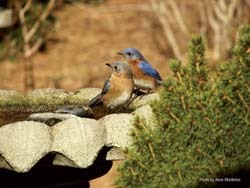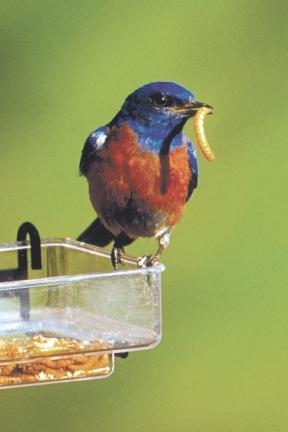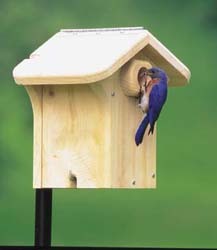How to Attract, Feed & House Bluebirds
Protection from predators and proximity to food and water are a bird’s primary consideration when choosing a nesting site. If bluebirds choose to nest in your yard, you can observe them as they build nests, lay eggs and feed their young. And when it’s time for the fledglings to leave the nest, they’ll likely learn to feed at your feeders and bathe in your bird baths.
|

|
Open Water
Offering water to drink and bathe is attractive to bluebirds; moving or dripping water is even more attractive. Keep the water fresh and watch them come in regularly to bathe and drink.
|
 |
Serve the Meal
Bluebirds primarily eat insects when available and supplement this main diet of insects with various seed and suet. Some of the more enticing feeder foods readily eaten by bluebirds include mealworms, our new Nesting SuperBlend™, sunflower chips, peanut splits and Jim’s Birdacious® Bark Butter® Bits.
Bluebirds will gobble up as many mealworms as you offer; especially when the young are being fed. Put some out in the morning and some in the evening and watch your bluebirds become regular visitors. suet is also a great first food item for young bluebirds.
Our WBU No-mess, Tree Nutty Plus and Bark Butter Bits are excellent alternative foods for a bluebird as they transition from their winter diet to their summer insect diet.
|
 |
Open House x2
Bluebirds are secondary cavity nesters, using pre-existing cavities. They don’t excavate their own. They readily use a well-placed nest box designed for them, preferring open areas such as fence rows.
Sometimes other birds will use a bluebird nest box, such as chickadees, titmice or wrens. If this happens, you can install a second box. The bluebirds will use one and the other bird species will use the other. For best results, try placing the two boxes about 20 - 30 feet from each other
|




